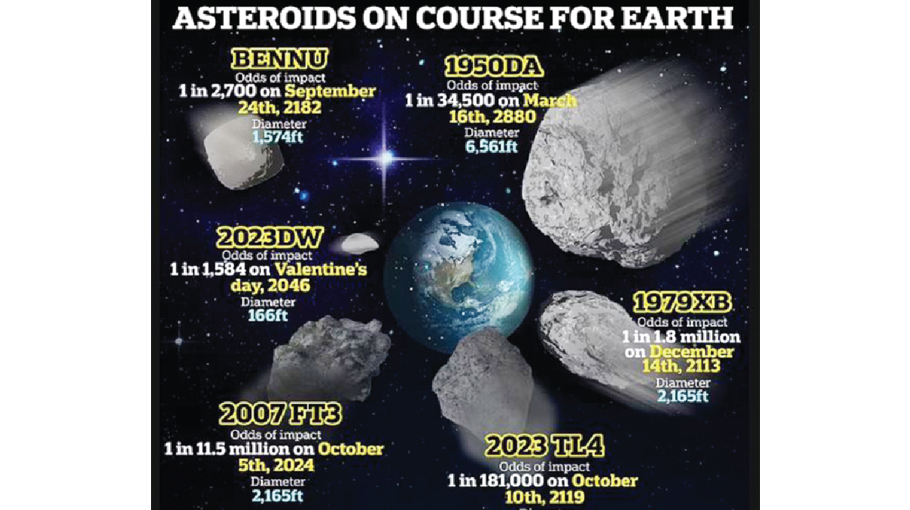Asteroids that could endanger Earth
New risks revealed after surprise Space Rock incident

Scientists have identified six asteroids with the potential to impact Earth, following a recent surprise collision with our atmosphere.
On Wednesday, Sept. 4, a one-meter-wide asteroid named 2024 RW1 burnt up over the Philippines. Discovered just eight hours before its fiery demise, it was too small to cause harm but highlighted the ongoing threat of space rocks.
NASA estimates that around 48.5 tonnes of meteoric material hit Earth daily, but most burn up harmlessly in the atmosphere. Large asteroids capable of causing significant damage are much rarer. Historically, such impacts have had profound effects, like the asteroid that killed the dinosaurs 66 million years ago or the Chelyabinsk meteor that exploded over Russia in 2013.
Here's a look at the six asteroids posing the highest risks:
1. Bennu
Size: 1,574 feet (0.49 km) in diameter
Risk: 1 in 2,700 chance of hitting Earth on September 24, 2182
- Impact: Could release energy equivalent to 1.4 billion tonnes of TNT
- Status: Studied by NASA's OSIRIS-REx spacecraft; currently monitored closely.
2. 2023 DW (Valentine’s Day Asteroid)
Size: 166 feet (50 metres) across
Risk: Previously 1 in 607, now 1 in 1,584 for February 14, 2046
- Impact: Could level a city if it hits
- Status: Risk is decreasing with continued observation.
3. 1950 DA
Size: 4,265 feet (1.3 km) in diameter
Risk: 1 in 34,500 chance of hitting Earth on March 16, 2880
- Impact: Would release energy equivalent to 75 billion tonnes of TNT
- Status: NASA and ESA are exploring methods to potentially divert it.
4. 2023 TL4
Size: 1,083 feet (0.33 km) in diameter
Risk: 1 in 181,000 chance of collision on October 10, 2119
- Impact: Could create a blast 150 times more powerful than the Tsar Bomba
- Status: Potentially manageable with early intervention.
5. 2007 FT3
Size: 2,165 feet (0.34 km) in diameter
Risk: 1 in 11.5 million for October 5, 2024; 1 in 10 million for March 3, 2030
- Impact: Low odds but still on ESA’s risk list
- Status: Closely monitored due to its relatively near future risk.
6. 1979 XB
Size: 2,165 feet (0.34 km) in diameter
Risk: 1 in 1.8 million
- Impact: Could destroy a city
- Status: Poorly understood orbit; needs further observation.
Despite these risks, experts like Dr. Greg Brown from the Royal Observatory Greenwich assure that there are no immediate threats. Current asteroid impacts are likely to occur over oceans or remote areas, minimising potential damage.
Dr Brown emphasises the importance of continued investment in planetary defence. Space agencies are actively working on projects like ESA's DART mission, which successfully deflected an asteroid in 2022.
The risk of a catastrophic asteroid impact remains low but is a case of "when, not if," making ongoing monitoring and preparation crucial.





